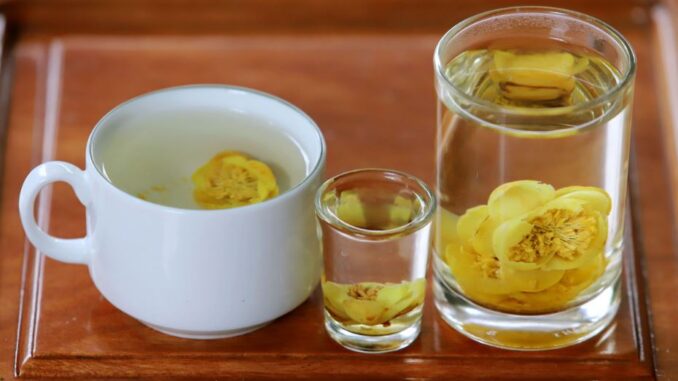
People in Que Phong district (Nghe An) go to the forest to pick and buy yellow tea flowers and dry them to make tea, selling from 3 to 15 million VND per kg.

Que Phong district is considered the “capital” of yellow flower tea in Nghe An with more than 200 hectares, of which 80 hectares are included in the conservation area.
Tea trees grow naturally in forests, concentrated in the communes of Thong Thu, Dong Van, Tien Phong, Muong Noc, Chau Kim, and Hanh Dich.
Que Phong is located in the tropical monsoon area, with high humidity and lots of dew, suitable for yellow flower tea trees to grow. In Vietnam, besides Nghe An, a number of northern provinces have yellow-flowered tea trees, such as Quang Ninh, Vinh Phuc, Bac Giang, and Yen Bai.

Yellow flower tea grows interspersed with many species of plants in Que Phong forest. The tree is 2-3 m high, the canopy is 1.5-2 m wide, blooms from November of the lunar calendar.
Mid-December of the lunar calendar is the end of the harvest of yellow flowers from tea trees, local people often bring bags and knives to the forest to pick from 4 am to late afternoon. A family sends 2-3 members to participate.
On average, each person picks 5 kg to 5 kg per day. One kilogram of fresh tea flowers picked from the forest is sold to traders for 180,000-300,000 VND.
“The business of picking yellow flowers takes place in about a month. In the main season, we earn from 200,000 to one million dong a day,” said one resident.

People often bring knives to cut bamboo trees to store flowers. The cork tree is cool, the flowers when stored inside will not be damaged or stamped. A bamboo tube one meter long, 5-7 cm in diameter will hold 1-1.5 kg of fresh flowers.
In Kim Son town, Que Phong district, there are many processing and trading establishments for yellow flower tea. Homeowners often mobilize human resources to go to communes in the area to meet people or traders to purchase, process and pack finished products. If buying from local people, they will get the original price, through the hands of traders, the price will increase by 20,000-30,000 VND/kg.
“One day I can buy 50-70 kg of fresh flowers,” said Sam Thi Thanh, 40, owner of Thanh Sam yellow flower tea factory in Kim Son town.

The purchased yellow flower is washed, put in a plastic basket to drain.

Near the 2022 Lunar New Year, yellow flower tea factories in Que Phong district are “sprinting” to have goods delivered to customers.
The dried yellow flowers will be separated from each petal for easy drying. At Ms. Thanh’s facility, every night, there are 30 people working, divided into 3 groups, each group has 10 people, salary 30,000-50,000 VND/person/session.
“In a month near Tet, there are days when people go to bed at 1-2 am,” said Ms. Thanh. In addition to seasonal workers, Ms. Thanh’s facility has about 4 regular workers, with a salary of 4-6 million VND/month.

“The extraction of flowers requires skillful hands and meticulousness. When peeling, it is necessary to keep the pistil, the petals must be beautiful. If you are careless, the flower will lose its petals and pistil,” said Luong Thi Hue, 40 years old, resident of the city. Kim Son town said.
In the evening from 19 to 23 pm, a group of 10 people peeled about 20-25 kg of flowers.

The peeled yellow flowers are placed evenly on the iron rigs of the dryer. One time the dryer is 30 kg. After 15 hours, when you see the stigma of dried flowers, you will meet the standards. For every 30 kg of fresh flowers, you will get 4-5 kg of dried flowers.

The temperature for drying yellow flower tea is 54-60 degrees Celsius. In addition to hot drying, many establishments also switch to cold drying. People in Que Phong maintain hot drying so that the yellow flower keeps its fragrance.

Dried yellow flowers will be packed into plastic boxes or packaging, cartons. On average, a kilogram of finished tea costs about 3 million VND, some types 6-9 million VND, special tea 15 million VND.

Yellow flower tea is mainly imported by people of Que Phong district for herbal companies (main market in Ho Chi Minh City, Hanoi), in addition to retail to serve the needs of some individuals and agencies.. . locality.
“Golden flower tea is sold from mid-December of the lunar calendar to the end of January of the following year. On average, each crop consumes nearly 3 quintals, earning about one billion dong. After deducting expenses, the revenue is about 200 million. Dong,” said Ms. Thanh.

In addition to selling dried tea, Ms. Sam Thi Thanh also takes the seeds of yellow-flowered tea trees from the forest and puts them in a small pot to nurse seedlings in the garden. When guests come to buy tea, she will give them a plant to bring home to plant for flowers to use.

When guests come to visit, the people of Que Phong often put dried yellow flowers in glasses or kettles to invite to drink. A pot of tea brews for 2 minutes.
Yellow flower tea gives water a deep yellow color, fragrant with the characteristic smell of flowers, with a slight bitter taste. This tea helps to sleep well, regulate blood pressure.
Mr. Ha Van Bay, an expert from the Department of Agriculture and Rural Development of Que Phong district, said that yellow flower tea is an endemic plant in the locality, 6 years ago the district had a project to preserve and develop this medicinal plant.
“A year, the area collects about 35-40 tons of fresh tea flowers, more than 10 tons of dried tea products. Currently, it is estimated that hundreds of households have a good source of income from natural tea plants,” said Mr. Bay.
Follow (vnexpress)
